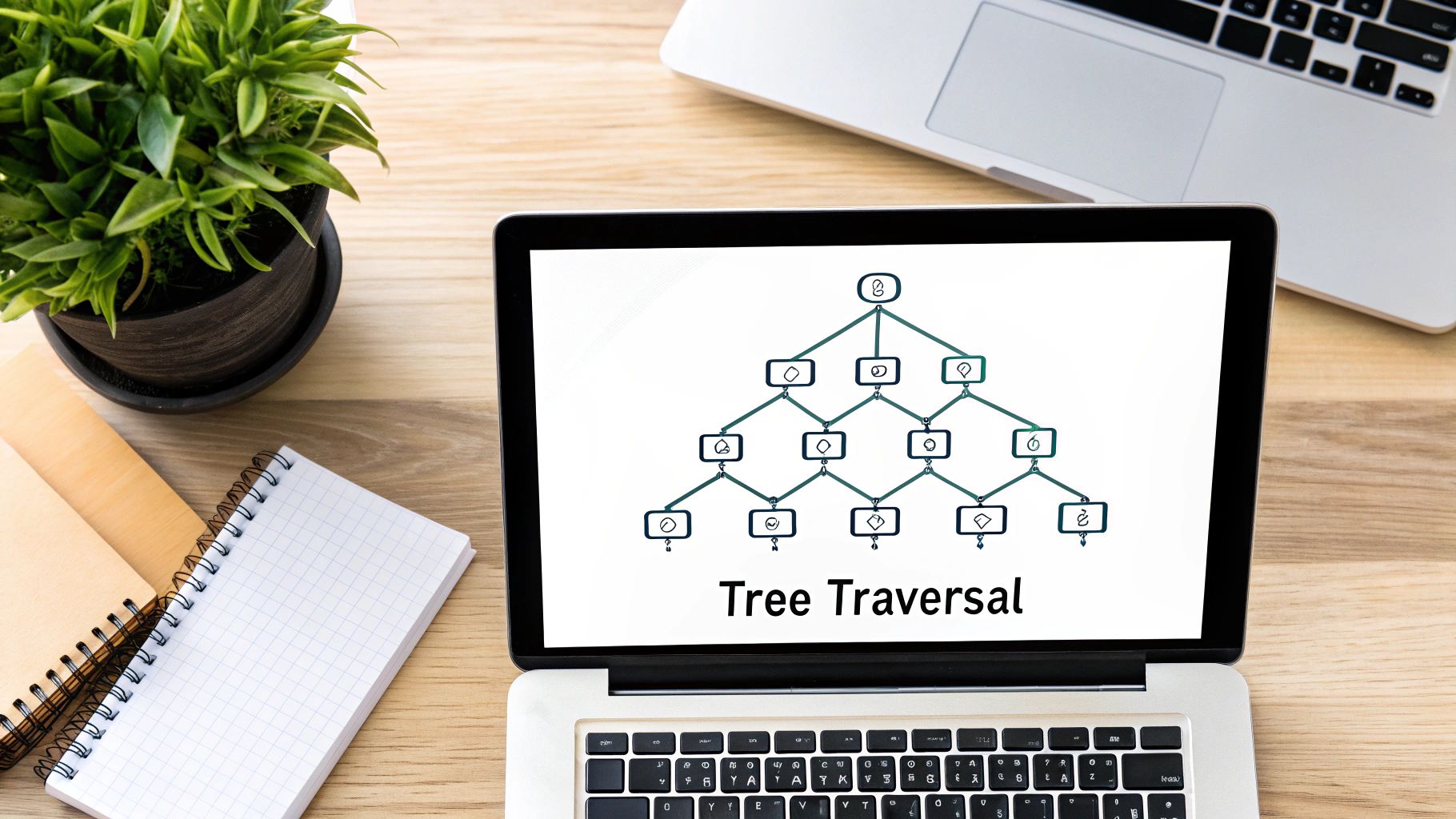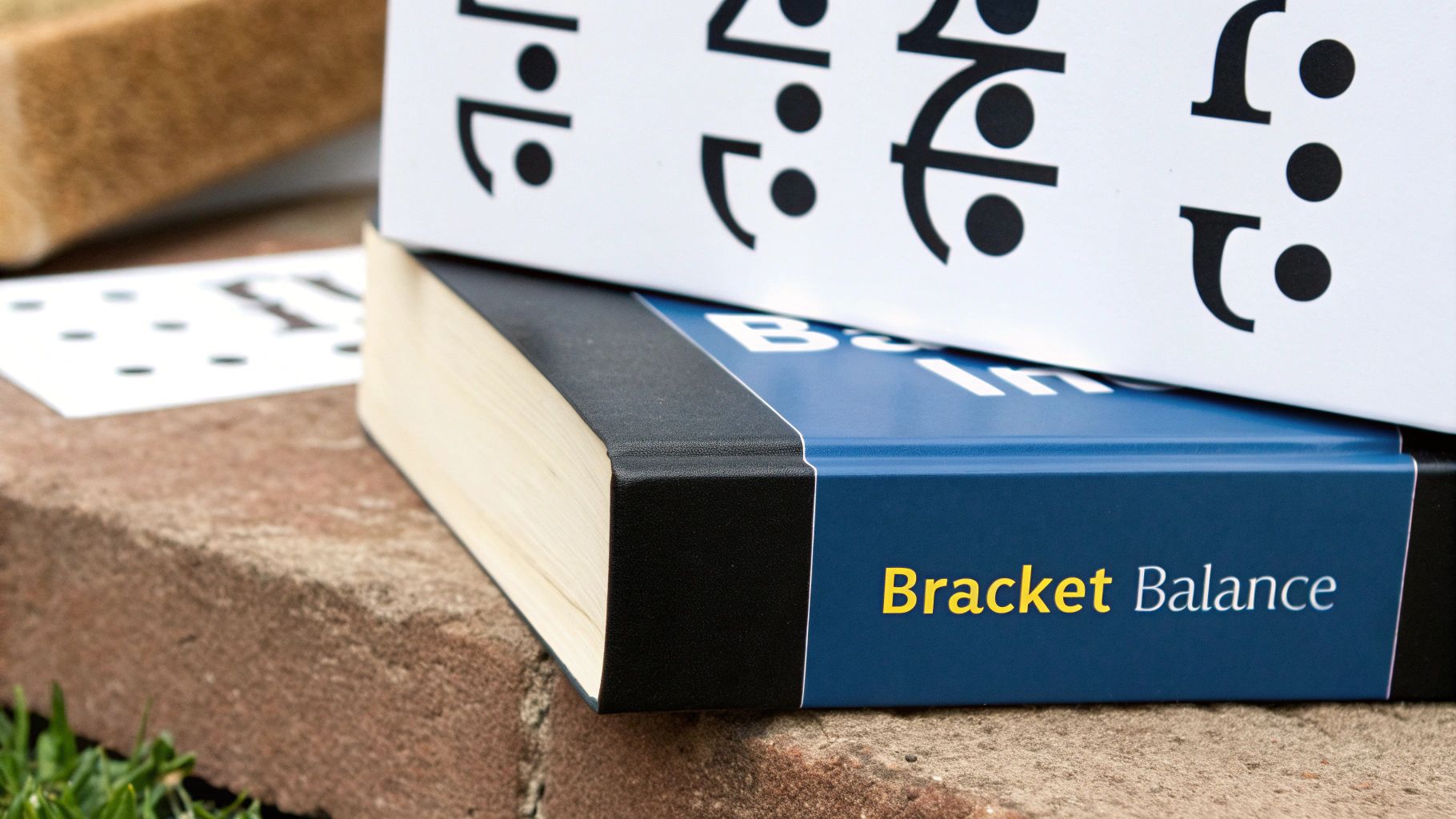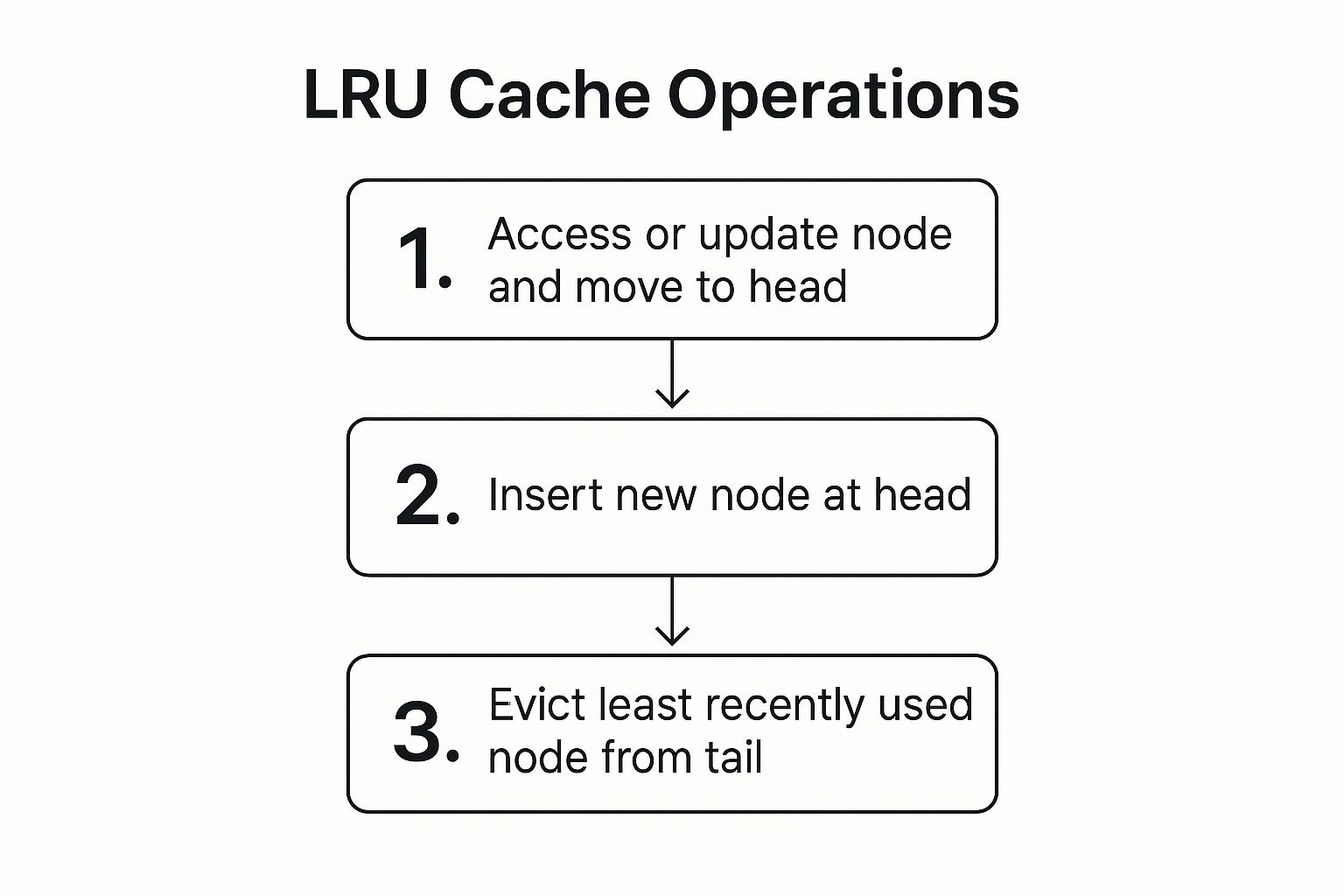Top 9 Data Structures Interview Questions to Master in 2025

Navigating the world of technical interviews can be daunting, but a solid grasp of data structures is your most powerful asset. For any software engineering role, a deep understanding of how to store, organize, and manage data efficiently is non-negotiable. Recruiters and hiring managers use data structures interview questions to test your foundational knowledge, problem-solving skills, and your ability to write clean, efficient code. Passing this part of the process is a critical step toward landing a top-tier tech offer.
This guide moves beyond simple theory. We will break down the nine most common and impactful data structures interview questions you'll likely encounter, from array and linked list manipulations to complex tree traversals and cache design. For each problem, we provide a clear explanation of the core concepts, multiple approaches to a solution, and optimized code examples in common programming languages.
Mastering these specific challenges will not only prepare you for the interview room but also build a stronger foundation for your entire software engineering career. This curated list is your roadmap to demonstrating technical excellence. Let's dive into the problems that separate a good candidate from a great one and unlock your next opportunity.
1. Array Two-Sum Problem
The Two-Sum problem is a classic among data structures interview questions, serving as an initial screening tool for a candidate's grasp of fundamental concepts. The task is straightforward: given an array of integers and a target number, find two numbers in the array that add up to the target. This problem effectively tests your ability to analyze time-space complexity and optimize a naive solution.

Its prevalence in interviews comes from its clear path to optimization. Candidates often start with a brute-force approach using nested loops, which results in O(n²) time complexity. The real test is whether you can identify the bottleneck and improve performance to a linear, O(n), solution.
How to Solve It: Hash Map Optimization
The most efficient solution involves a single pass through the array, using a hash map (or a dictionary in Python) to store numbers you have already seen. For each element num, calculate the required complement: complement = target - num.
Before adding num to the hash map, check if complement already exists as a key. If it does, you have found your pair. If not, add the current num and its index to the map and move to the next element. This strategy leverages the hash map's average O(1) lookup time, reducing the overall time complexity to O(n).
Key Insight: The hash map trades space for time. By using O(n) extra space for the map, you reduce the time complexity from a quadratic O(n²) to a much faster linear O(n).
Actionable Interview Tips
- Start with Brute Force: First, explain the nested loop O(n²) solution to demonstrate you understand the basic logic.
- Discuss Optimization: Proactively suggest using a hash map to improve performance, explaining the time-space trade-off.
- Handle Edge Cases: Mention how you would handle an empty array, an array with fewer than two elements, or cases where no valid pair exists.
- Clarify Ambiguities: Ask if the array contains duplicates or if it is sorted. If it's sorted, you could also propose a two-pointer approach as an alternative O(n) solution with O(1) space.
2. Linked List Cycle Detection
Linked List Cycle Detection is a fundamental problem often featured in data structures interview questions. It tests a candidate's ability to manipulate pointers, understand linked list traversal, and devise algorithms that are efficient in both time and space. The challenge is to determine if a given linked list has a "cycle," meaning a node points back to a previous node in the list, creating an infinite loop.
This problem is a favorite for interviewers because its optimal solution is not immediately obvious. It requires a clever approach beyond simple traversal, pushing candidates to think about relative speeds and pointer interactions. Successfully solving it demonstrates a deeper understanding of data structures beyond basic operations.
How to Solve It: Floyd's Tortoise and Hare Algorithm
The most elegant solution is Floyd's Cycle Detection Algorithm, also known as the "tortoise and hare" algorithm. This method uses two pointers, a "slow" pointer and a "fast" pointer, that traverse the list simultaneously but at different speeds. The slow pointer moves one step at a time, while the fast pointer moves two steps.
If the linked list contains a cycle, the fast pointer will eventually enter the loop and lap the slow pointer, at which point they will meet at the same node. If the fast pointer reaches the end of the list (i.e., null), it means no cycle exists. This approach brilliantly solves the problem in O(n) time complexity with O(1) space, as no extra data structures are needed.
Key Insight: The relative speed difference between the two pointers guarantees that if a cycle exists, they will inevitably meet. The fast pointer gains on the slow pointer by one node with each iteration inside the cycle.
Actionable Interview Tips
- Explain the Two-Pointer Logic: Clearly articulate the concept of a slow (one step) and fast (two steps) pointer.
- Walk Through an Example: Use a whiteboard or scratchpad to trace the pointers through a small linked list with a cycle to prove the concept.
- Handle Edge Cases: Discuss what happens with an empty list, a single-node list, or a two-node list with no cycle. The algorithm should handle these gracefully.
- Mention the "Why": Explain why this method is superior to a hash-based solution, highlighting its O(1) space complexity advantage.
3. Binary Tree Traversal (Inorder, Preorder, Postorder)
Binary tree traversal questions are a staple in data structures interviews, designed to evaluate your understanding of tree-based data structures and recursion. The task involves visiting every node in a binary tree exactly once in a specific order: Inorder (left, root, right), Preorder (root, left, right), or Postorder (left, right, root). These problems test foundational computer science concepts and your ability to think algorithmically.

Interviewers favor this topic because it has both simple recursive solutions and more complex iterative ones. Your ability to explain and implement both demonstrates a deeper command of data structures, particularly the relationship between recursion and the call stack. The different traversal orders also have practical applications, like Inorder traversal of a Binary Search Tree (BST) yielding a sorted sequence.
How to Solve It: Recursive and Iterative Approaches
The most intuitive way to implement tree traversals is with recursion. For an Inorder traversal, you would write a function that recursively calls itself on the left child, processes the current node's value, and then recursively calls itself on the right child. Preorder and Postorder follow a similar pattern, just changing the order of operations.
For an iterative solution, you must explicitly manage the traversal using a stack. For example, in an iterative Inorder traversal, you would push nodes onto a stack while traversing down the left side of the tree. Once you can't go left anymore, you pop a node, process its value, and then move to its right child.
Key Insight: Recursion offers a clean, readable solution by implicitly using the call stack. The iterative approach, using an explicit stack, provides the same result without recursion depth limits and is crucial to understand for more complex tree problems.
Actionable Interview Tips
- Master Recursion First: Start by thoroughly understanding and coding the recursive solutions for all three traversals. They are the most straightforward.
- Implement Iteratively: Be prepared to write iterative solutions using a stack. This shows you understand how recursion works under the hood.
- Know Traversal Orders: Memorize the patterns: Inorder (left-root-right), Preorder (root-left-right), and Postorder (left-right-root).
- Discuss Space Complexity: Mention that a recursive solution can have O(h) space complexity due to the call stack, where h is the tree height. Also, be ready to discuss advanced concepts like Morris Traversal for an O(1) space solution.
4. Valid Parentheses/Bracket Matching
The Valid Parentheses problem is a staple in technical interviews, prized for its direct application of the stack data structure. The challenge asks you to determine if a string containing just the characters '(', ')', '{', '}', '[' and ']' is "valid." A string is valid if open brackets are closed by the same type of bracket in the correct order. This question is a go-to for assessing a candidate's understanding of stack operations (LIFO - Last-In, First-Out).

Its popularity stems from its relevance to real-world parsing problems, such as validating code syntax in an IDE or parsing JSON and XML files. The problem requires careful attention to detail and a clear, logical thought process, making it an excellent gauge of a developer's foundational skills.
How to Solve It: Using a Stack
The optimal solution involves iterating through the string and using a stack to keep track of opening brackets. When you encounter an opening bracket ((, {, [), push it onto the stack. When you find a closing bracket (), }, ]), check the top of the stack.
If the stack is empty or the top element is not the corresponding opening bracket, the string is invalid. If they do match, pop the opening bracket from the stack and continue. After iterating through the entire string, the stack must be empty for the string to be considered valid. Any remaining brackets on the stack indicate an unclosed pair.
Key Insight: The stack's LIFO property perfectly models the nested structure of brackets. The last opening bracket you see must be the first one to be closed.
Actionable Interview Tips
- Explain the Stack's Role: Start by identifying the stack as the ideal data structure and explain why its LIFO behavior is perfect for this problem.
- Use a Hash Map for Mappings: Suggest using a hash map to store the relationships between closing and opening brackets (e.g.,
key: '}', value: '{'). This makes your code cleaner and easier to read. - Cover All Edge Cases: Discuss what happens with an empty string (it's valid), a string with only opening or closing brackets, and a mismatched string like
([)]. - Final Stack Check: Emphasize the crucial final step: checking if the stack is empty at the end. A non-empty stack means there are unclosed opening brackets, making the string invalid.
5. Binary Search Implementation
Implementing binary search is a cornerstone of data structures interview questions, designed to test a candidate's grasp of the divide-and-conquer strategy. The problem requires you to find a target value within a sorted array by repeatedly dividing the search interval in half. It’s a powerful algorithm that showcases your ability to handle array indices and optimize search operations.
Its frequent appearance in interviews stems from its efficiency and the subtle implementation details that separate a correct solution from a buggy one. Interviewers use it to evaluate your precision with pointers, loop conditions, and your understanding of logarithmic time complexity, O(log n), which is a massive improvement over a linear scan.
How to Solve It: The Iterative Approach
The most common and memory-efficient way to implement binary search is iteratively. You start with two pointers, left and right, at the beginning and end of the array, respectively. The core of the algorithm is a while loop that continues as long as left is less than or equal to right.
Inside the loop, you calculate the middle index mid. To prevent potential integer overflow in languages like C++ or Java, it's safer to calculate it as mid = left + (right - left) / 2. You then compare the element at mid with the target. If they match, you've found the element. If the target is larger, you discard the left half by setting left = mid + 1. If it's smaller, you discard the right half by setting right = mid - 1.
Key Insight: The algorithm's power lies in eliminating half of the remaining search space with each comparison. This "divide and conquer" approach is what enables its O(log n) time complexity.
Actionable Interview Tips
- Handle Edge Cases: Discuss what happens with an empty array or if the target element is not found. The loop will terminate naturally when
left > right, at which point you can return -1. - State Preconditions: Always start by mentioning that binary search requires the input array to be sorted.
- Be Precise with Bounds: Explain your loop condition (
left <= right) and why you update the pointers tomid + 1andmid - 1. This precision prevents infinite loops and ensures you don't miss the target. - Consider Recursion: Briefly mention that a recursive implementation is also possible but might be less space-efficient due to the call stack overhead (O(log n) space).
6. Hash Table/HashMap Implementation
Designing a hash table from scratch is a fundamental data structures interview question that probes your understanding of core computer science principles. The task requires you to create a data structure that supports key-value pair storage with fast average-case insertion, deletion, and retrieval. This question tests your knowledge of hashing functions, collision resolution, and dynamic memory management.
Its popularity in interviews stems from its real-world applicability in systems like database indexes and caches. Answering it well shows you can think about trade-offs between different implementation strategies and their impact on performance, a crucial skill for any software engineer.
How to Solve It: Key Components and Collision Handling
A successful implementation requires three main components: a storage array, a hashing function, and a collision resolution strategy. The hashing function converts a key into an array index. Since different keys can map to the same index (a "collision"), you must handle it.
The most common strategy is chaining, where each array index points to a linked list of all key-value pairs that hashed to that index. Another method is open addressing, where you probe for the next available slot in the array itself. As the table fills, performance degrades, so you must also implement dynamic resizing when the "load factor" (items/size) exceeds a threshold like 0.75.
Key Insight: The choice of a good hash function is critical. A poor function leads to frequent collisions, degrading the hash table's performance from an average O(1) to a worst-case O(n), effectively turning it into a linked list.
Actionable Interview Tips
- Start with the Core Logic: Begin by outlining the main components: the underlying array, the hash function (e.g., using modulo), and the structure to store key-value pairs.
- Discuss Collision Resolution: Clearly state your chosen collision handling strategy (chaining is often simpler to implement live) and explain why you picked it over alternatives like open addressing.
- Plan for Resizing: Proactively mention the need for resizing the internal array based on a load factor. Describe how you would create a new, larger array and rehash all existing elements.
- Implement Key Methods: Be prepared to code the
put,get, andremovemethods, paying close attention to edge cases like a key not existing or handling collisions correctly within your chosen strategy.
7. Merge Two Sorted Lists/Arrays
The "Merge Two Sorted Lists/Arrays" problem is a staple in data structures interview questions, designed to test a candidate's proficiency with pointer manipulation and iterative algorithms. The task is to combine two already sorted lists (or arrays) into a single, new sorted list. This problem is foundational, as it forms the core logic of the widely used Merge Sort algorithm.
Its value in an interview setting lies in its direct application of the two-pointer technique. It requires candidates to manage multiple states (the current position in each list) while building a new structure, all without breaking the sorted order. The interviewer assesses your ability to handle comparisons, pointer advancement, and edge cases, such as one list being exhausted before the other.
How to Solve It: The Two-Pointer Approach
The optimal solution involves iterating through both input structures simultaneously using two pointers, one for each list or array. Start by initializing a new list or array to store the result. At each step, compare the elements pointed to by the two pointers. Append the smaller of the two elements to the result list and advance the pointer of the list from which the element was taken.
Continue this process until one of the pointers reaches the end of its respective list. At that point, the remaining elements in the other list are already sorted, so you can simply append all of them to the end of your result list. This method ensures you only traverse each element once, achieving a time complexity of O(n + m), where n and m are the lengths of the two lists.
Key Insight: The two-pointer technique avoids re-sorting the combined list. By leveraging the pre-sorted nature of the inputs, you build the final sorted list in a single, efficient pass, minimizing computational overhead.
Actionable Interview Tips
- Verbalize the Logic: Clearly explain your two-pointer strategy before you start coding. Describe how you'll initialize pointers, compare elements, and handle the final append step.
- Discuss Data Structures: Clarify whether you are merging linked lists or arrays, as the implementation details will differ. For linked lists, you'll manipulate
nextpointers; for arrays, you'll manage indices. - Handle Remaining Elements: A common mistake is forgetting to append the rest of the non-exhausted list. Explicitly mention how you will handle this clean-up phase.
- Consider In-Place Merging: For arrays, an interviewer might ask about an in-place merge to save space (O(1) space complexity). Be prepared to discuss the complexities and trade-offs of this more advanced variation.
8. Lowest Common Ancestor (LCA) in Binary Tree
Finding the Lowest Common Ancestor (LCA) of two nodes in a binary tree is a frequent challenge in data structures interview questions. It tests a candidate's proficiency with tree traversal, recursion, and the fundamental relationships within tree structures. The problem asks for the lowest node in the tree that has both given nodes as descendants, where a node can be a descendant of itself.
This question is a favorite among interviewers because it elegantly assesses recursive thinking. A candidate must devise a strategy to explore the tree and propagate information from the bottom up to identify the ancestor. Its applications range from finding a common directory in a file system to identifying a merge base in Git version control.
How to Solve It: Recursive Post-Order Traversal
A clean and efficient solution uses a recursive Depth-First Search (DFS) with a post-order traversal pattern. The function recursively calls itself on the left and right children. The key is how information is returned up the call stack. The base case for the recursion is when the current node is null or matches one of the two target nodes.
If a recursive call on a subtree returns a non-null node, it means one of the target nodes was found. If the calls on both the left and right subtrees return non-null nodes, the current node is the LCA. If only one subtree returns a non-null node, that node is passed up the call stack.
Key Insight: The post-order traversal ensures you evaluate a node only after visiting its entire left and right subtrees. This "bottom-up" approach allows a node to decide if it's the LCA based on what its children have found.
Actionable Interview Tips
- Explain the Recursive Logic: Start by clearly articulating the recursive strategy, focusing on the base cases (node is null or a target) and the logic for propagating results.
- Consider a Binary Search Tree (BST): Ask if the tree is a BST. If so, mention the optimized O(log n) solution where you can use the node values to decide whether to traverse left or right.
- Discuss Edge Cases: Cover scenarios like one node being the ancestor of the other, nodes not being present in the tree, or the root being one of the nodes.
- Handle Both Children: Clearly explain the critical step: if the left child returns one target and the right child returns the other, the current node is the LCA. This is the core of the algorithm.
9. Design LRU (Least Recently Used) Cache
Designing a Least Recently Used (LRU) Cache is a staple of system design and data structures interview questions. It requires implementing a cache with a fixed capacity that automatically evicts the least recently used item when it becomes full. The challenge lies in performing both get and put operations in O(1) time complexity, testing your ability to combine multiple data structures to meet performance constraints.
This problem is a favorite at companies like Google and Amazon because it evaluates practical knowledge of how to build efficient data retrieval systems. Success depends on understanding how to integrate the fast lookups of a hash map with the ordered, efficient node manipulation of a doubly linked list.
How to Solve It: Combining a Hash Map and Doubly Linked List
The optimal solution uses a hash map for O(1) key-based lookups and a doubly linked list to maintain the order of use. The hash map stores keys and pointers to the nodes in the linked list, while the linked list tracks which items are most and least recently used. The head of the list holds the most recent item, and the tail holds the least recent one.
When an item is accessed (a get or put operation), it is moved to the head of the list. If a put operation causes the cache to exceed its capacity, the item at the tail of the list is removed. This combination ensures that all core operations remain constant time.
Key Insight: The hash map provides the O(1) access, while the doubly linked list provides the O(1) eviction and reordering capabilities. Neither structure alone can achieve the required performance.
The following infographic illustrates the core logic for managing nodes within the LRU cache.

This process flow visualizes how accessing a node, inserting a new one, or evicting the oldest entry are all handled by manipulating the head and tail of the linked list.
Actionable Interview Tips
- Explain the Data Structures: Start by explaining why a hash map and a doubly linked list are the right tools for the job and how they work together.
- Draw the Architecture: Use the whiteboard to draw the hash map pointing to nodes in the linked list. Walk through
get,put(new item), andput(existing item) scenarios. - Manage Pointers Carefully: Code the logic for moving nodes to the head and removing nodes from the tail. Be meticulous with updating
nextandprevpointers to avoid breaking the list. - Discuss Edge Cases: Consider what happens if the cache is initialized with zero or negative capacity, or if you try to
geta non-existent key.
9 Key Data Structures Interview Questions Comparison
| Item | Implementation Complexity 🔄 | Resource Requirements ⚡ | Expected Outcomes 📊 | Ideal Use Cases 💡 | Key Advantages ⭐ |
|---|---|---|---|---|---|
| Array Two-Sum Problem | Low to Medium | Moderate (uses hash map) | Efficient pair finding (O(n)) | Price matching, transaction pairing, gaming | Simple, multiple solutions, real-world usage |
| Linked List Cycle Detection | Medium | Low (constant space) | Cycle detection with O(1) space | Memory leak detection, loop prevention | Space efficient, elegant algorithm |
| Binary Tree Traversal | Medium | Moderate (stack/recursion) | Systematic node visiting | File systems, expression evaluation, compilers | Tests recursion & iteration, multiple patterns |
| Valid Parentheses/Bracket Matching | Low | Low (stack storage) | Validation of balanced brackets | Syntax validation, parsing expressions | Simple logic, direct stack use |
| Binary Search Implementation | Low to Medium | Low (constant space) | Logarithmic search O(log n) | Database lookups, dictionary search | Very efficient, no extra space |
| Hash Table/HashMap Implementation | Medium to High | Moderate to High (memory + resizing) | Fast key-value access ~O(1) | Caching, indexing, symbol tables | Fast average access, fundamental data structure |
| Merge Two Sorted Lists/Arrays | Low to Medium | Moderate (extra space for output) | Linear time merging O(m+n) | Data merging, time series, distributed systems | Stable, memory efficient in-place options |
| Lowest Common Ancestor (LCA) | Medium | Moderate (recursion depth) | Finds common ancestor in trees | File systems, organizational charts, version control | Recursive elegance, multiple approaches |
| Design LRU Cache | Medium to High | High (hash map + linked list) | O(1) get/put cache performance | CPU caching, browser cache, database buffers | Optimal speed, real-world application |
From Theory to Hire: Your Next Steps in Interview Mastery
Navigating the landscape of technical interviews can feel like a daunting challenge, but you have now reviewed a curated list of the fundamental data structures interview questions that consistently appear in today's top tech companies. From the foundational Two-Sum problem using arrays to the intricate design of an LRU Cache, each question serves a distinct purpose: to test not just your coding ability, but your problem-solving process and your grasp of core computer science principles.
The journey from seeing a problem to implementing an optimal solution is what truly separates a good candidate from a great one. Remember, interviewers are less interested in a perfect, memorized answer and more interested in how you approach ambiguity, analyze constraints, and articulate the trade-offs between different data structures.
Key Takeaways for Your Preparation
The problems we've covered, such as detecting a cycle in a linked list or traversing a binary tree, are more than just academic exercises. They are practical tools for evaluating your ability to handle pointers, recursion, and space-time complexity. The real takeaway is recognizing the underlying patterns. The fast-and-slow pointer technique used for cycle detection, for example, can be adapted to solve other list-based problems. Similarly, understanding hash maps is crucial for optimizing solutions from O(n^2) to O(n).
Your goal should be to internalize these patterns so deeply that you can identify which data structure or algorithm is best suited for a new, unfamiliar problem. This pattern recognition is the true skill that interviewers are searching for.
Actionable Next Steps to Secure Your Offer
Mastering these concepts requires consistent, deliberate practice. Here’s a strategic roadmap to guide you:
- Implement from Scratch: Don't just read the solutions. Open your favorite code editor and build each data structure and algorithm from the ground up. Implement a
LinkedList, aBinarySearchTree, and aHashMapwithout relying on built-in libraries. This hands-on practice solidifies your understanding. - Explain It Out Loud: Practice articulating your thought process. Use a whiteboard or a simple text editor and talk through your solution as if you were in an interview. Explain why you chose a specific data structure and analyze its complexity. This verbalization is a critical skill.
- Expand Your Problem Set: Use platforms like LeetCode and HackerRank to find variations of these classic problems. Filter by data structure and difficulty to target your weak points systematically. Aim for consistent practice rather than cramming.
Beyond mastering these technical concepts, remember that your professional brand is equally important in today's competitive market. After all, your technical skills need to be discovered by recruiters first. A well-crafted online presence can make the difference between waiting for opportunities and having them come to you. Taking the time to optimize your professional portfolio, including building a strong LinkedIn profile, ensures that your expertise gets the visibility it deserves. Ultimately, your preparation for data structures interview questions is one part of a larger strategy to showcase your value and land the role you want.
Ready to take your interview preparation to the next level? ParakeetAI provides real-time, AI-powered assistance to help you structure your thoughts, get unstuck on difficult problems, and articulate your solutions with clarity and confidence. Turn your practice sessions into a powerful tool for success with ParakeetAI.




